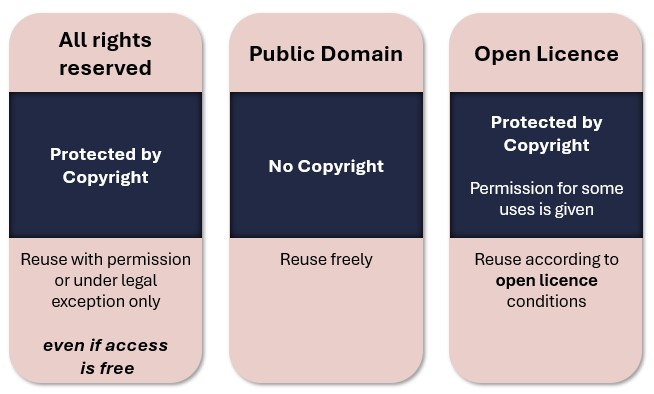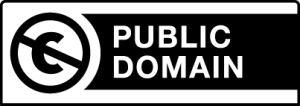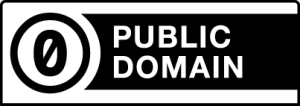Open Access: All rights reserved, public domain or open licence?
All rights reserved | Public domain | Open licences | Proprietary open content licences | Check your understanding

When a work is created the default status is © ‘all rights reserved’. This means the copyright owner reserves all rights to reproduce, distribute, display, publish, adapt or perform. The copyright owner might choose to publish their work on a website or social media channel, or open access journal so that it is free to read or view. If it is music or a podcast it might be free to listen to. Users may be able to download the work for their own private use, however users may not upload, copy, distribute, display, publish or adapt the work without getting permission from the copyright owner.
© ‘all rights reserved’ works can only be reused with a licence or permission from the copyright owner even if access is free, unless there is an exception in the Copyright Act.
![]()
Assume a work is ‘all rights reserved’ unless otherwise stated.
Public domain
Public domain means works are not subject to copyright and can be used freely without permission. Just because something is freely available on the internet does not mean it is in the ‘public domain’ for copyright purposes.
Works can be in the public domain when the copyright duration has expired; or they are outside the scope of copyright or the creator has waived their copyright and dedicated their work to the public domain.
Copyright expiry
Copyright protection expires a number of years after an author dies or in some cases, after the date of creation of a work. The exact duration or number of years varies by the type of work and jurisdiction.
In Australia, general copyright duration is the life of the author plus 70 years from the end of the calendar year that the author died, but specific duration depends on the material type and when it was published. (Australian Government, Duration of Copyright Table).
Copyright duration varies by country therefore a work may be in the public domain in one country, while still protected by copyright in another country. In New Zealand the standard copyright duration is life of the author plus 50 years.
The shortest duration is in Yemen, with life of creator +30 years and the longest is in Mexico with life of creator +100 years (List of copyright duration by country, Wikipedia, 2024).
Scope
Certain works in some countries are outside of the scope of copyright. These are usually official legislative, administrative and legal texts and statutes. Some material created by the US federal government is public domain for users in the United States (Wikipedia, 2024).
Unregistered works may be public domain in countries that require copyright registration.
Ideas, styles, data, facts, methods, concepts, languages and unoriginal names, titles and slogans are not protected by copyright, however other IP protections may apply.
Dedication
Creative Commons public domain tools
Creative Commons offer two tools for users to indicate public domain status of material.
| Badge | Name | Tool description |
|---|---|---|
 |
Public Domain Mark | The Public Domain Mark is a label that can be used to indicate a work has no known copyright. It has no legal code, but it does have metadata. It is often used by galleries, libraries, archives and museums for old works. The work must be in the public domain in all jurisdictions. |
 |
Creative Commons Zero (CC0) | The Public Domain Dedication tool can be used by a creator to waiver all rights under copyright law. The deed includes a licence allowing anyone to use the work in any manner unconditionally and a promise to not assert copyright so that it can be used in jurisdictions that do not permit public domain dedication. |
Open licences
Open licences are a set of conditions applied to a work that allow others to use it as long as they follow the terms set out by the licence. A copyright owner can apply an open licence that lets others use their work in ways that would normally require express permission under copyright. These licences usually allow free use and redistribution, provided the creator is credited, and are often described as ‘some rights reserved’.
Open licences underpin open access principles and open scholarship movements worldwide.
Open access is defined as free availability on the public internet, permitting any users to read, download, copy, distribute, print, search or link to the full text of articles, crawl them for indexing, pass them as data to software or use them for any other lawful purpose… The Budapest Open Access Initiative
There are several open licences, among the most common are Creative Commons licences, open software licences such as the GNU General Public Licence and the Open Data Commons Open Database Licence (ODbL).
Proprietary open content licences
Some platforms and content providers offer terms of use where neither permission nor attribution is required and material may be used free of charge, for example: Pexels licence; and Unsplash licence.
Other proprietary licences, such as Canva Pro content licence and the Noun Project royalty free licence offer use of their content without attribution for a fee.
Use of works from free content platforms may be restricted in some ways (e.g. reselling) or require registration. Works from open content platforms are protected by copyright unless otherwise indicated, and licence conditions should always be reviewed and followed.
Check your understanding
Text only version of dialog cards (h5p 1)
Card 1: What is the difference between ‘free to read’ and open access?
With ‘free to read’ all rights are reserved. Many documents and websites are free to read or view, but the contents are not free to redistribute or reuse without permission from the copyright owner.
Truly open access works have an open licence that permits free redistribution and reuse. Some rights, such as the right of attribution, are reserved.
Card 2: What is the difference between public domain and open access?
Works in the public domain are free to use with no copyright constraints. No rights are reserved. (Note that academic integrity still requires citation to avoid plagiarism.)
Open access means a work has an open licence. Open licenses recognise clear ownership of intellectual property and the work is still protected by copyright. Users must follow the licence conditions. Some rights are reserved.

